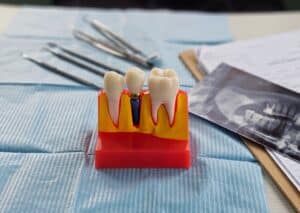Before George Washington’s Wooden Teeth, Dentists Thought About Correcting Bad Bites
Even ancient people wanted straight teeth! According to the AAO (American Association of Orthodontists), archaeologists have discovered mummified ancients with crude metal bands wrapped around individual teeth. Later, in 400-500 BC, Hippocrates and Aristotle both ruminated about ways to straighten teeth and fix various dental conditions. Straight teeth have been on our minds a very long time!
Important Breakthroughs
In 1728, French Dentist Pierre Fauchard published a book called the “The Surgeon Dentist” with an entire chapter on ways to straighten teeth. Fauchard used a device called a “Bandeau,” a horseshoe-shaped piece of precious metal which helped expand the arch.
In 1819 Delabarre introduced the wire crib, which marked the birth of contemporary orthodontics. The term orthodontia was coined by Joachim Lafoulon in 1841.
The First Metal Mouths
What did braces look like a century ago? In the early 1900s, orthodontists used gold, platinum, silver, steel, gum rubber, vulcanite (and occasionally, wood, ivory, zinc, copper, and brass) to form loops, hooks, spurs, and ligatures. Fourteen- to 18-karat gold was routinely used for wires, bands, clasps, ligatures, and spurs, as were iridium-platinum bands and arch wires, and platinized gold for brackets. Why gold? It is malleable and easy to shape — the original “metal mouth” was real gold or silver! How’s that for bling?
Advancements in the 1970s
Braces continued to wrap around the teeth until the mid-1970s, when direct bonding became a reality. Why did it take so long for dentists to invent the modern bonded bracket? The adhesive! The bonded bracket was actually invented earlier, but the formulation for the adhesive wasn’t perfected until almost a decade later.
Around this time, the self-ligating bracket also appeared on the scene. Self-ligating brackets don’t need tie wires or elastic ligatures to hold the arch wire onto the bracket — they are held on by a “trap door” built into each bracket. As early as 1935, the idea of a self-ligating brackets began to take shape.
In the 1970s, Earl Bergersen, DDS created the passive Ortho-Tain appliances, which guide jaw growth and help correct orthodontic problems and malocclusions in both children and adults. The Ortho-Tain appliances look like custom plastic mouth-guards, and are worn mainly at night, or for only a few hours each day. In many cases, people have been able to correct (or greatly diminish) many types of orthodontic problems with these removable custom-made appliances.
Around 1975, two orthodontists working independently in Japan and the United States started developing their own systems to place braces on the inside surfaces of the teeth — lingual braces. These “invisible braces” offered people the results of bonded brackets with one big advantage — they were on the inside of the teeth, so nobody else could see them!
Lingual braces were the “invisible” braces of choice until the early 1980s, when “tooth colored” esthetic brackets made from single-crystal sapphire and ceramics came into vogue.
Invisible Braces
As far back as 1945, orthodontists realized that a sequence of removable plastic appliances could move teeth toward a predetermined result. Some orthodontists even made simple plastic “aligner trays” in their offices for minor adjustments. But it took an adult who’d just had braces to take the concept a step further.
Invisalign was the brainchild of Zia Chishti and Kelsey Wirth, graduate students in Stanford University’s MBA program. Wirth had traditional braces in high school (she reportedly hated them). Chishti had finished adult treatment with traditional braces and now wore a clear plastic retainer. He noticed that if he didn’t wear his retainer for a few days, his teeth shifted slightly — but the plastic retainer soon moved his teeth back to the desired position. In 1997, he and Wirth applied 3-D computer imaging graphics to the field of orthodontics and created Align Technologies and the Invisalign method. With a boost from ample Silicon Valley venture funding, Align soon took the orthodontic industry by storm. Dentists and other dental companies were skeptical at first, because neither Chishti nor Wirth had any professional dental training. Invisalign braces were first made available to the public in May 2000 and proved extremely popular with patients.
The Future: Technology Continues to Advance
As technology enhances our daily lives, it also continues to advance the science of orthodontics. More and more companies are utilizing digital computer imaging to make orthodontic treatment more precise. The SureSmile system by OraMetrix, for example, takes a detailed 3-D model of a patient’s teeth and helps the orthodontist develop a precise treatment plan for tooth movement. The orthodontist’s treatment plan then drives a highly accurate robotic process to customize the arch wires needed for treatment. This often shortens treatment time and gives highly accurate results.
NASA developed one of the late 20th century’s most dramatic orthodontic breakthroughs: heat-activated nickel-titanium alloy wires. At room temperature, heat-activated nickel-titanium arch wires are very flexible. As they warm to body temperature they become active and gradually move the teeth in the anticipated direction. Because of their high-tech properties, these wires retain their tooth-moving abilities longer than ordinary metal wires and need less frequent attention from the orthodontist.
What does all this mean for the orthodontic patient of the future? As companies develop more precise, high-tech materials and methods, your braces will be on for a shorter period of time, be smaller and less visible, result in less discomfort, and give great results. We’ve sure come a long way from the wrap-around “metal mouth” – and that’s something we can all smile about!
Source: ArchWired.com


